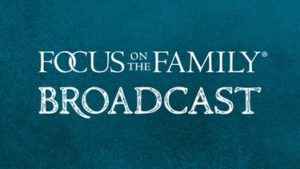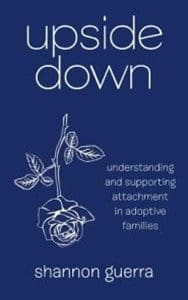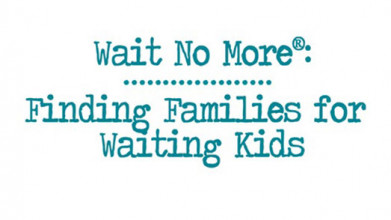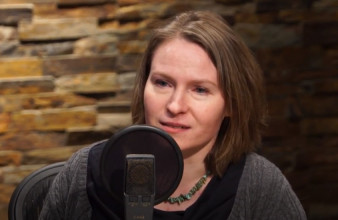Opening:
Excerpt:
Shannon Guerra: An adoptive child or a foster child – a child who’s grown up in trauma, whose brain is literally wired differently – they don’t understand this stuff. And it’s going to take a long time to rewire that, if we ever can. And they need to understand that this adult who’s coming in, who hands you a piece of candy, they’re not going to provide for you for life. And they don’t understand the difference.
End of Excerpt
John Fuller: Shannon Guerra joins us today on Focus on the Family. And your host is Focus president and author Jim Daly. Thanks for joining us. I’m John Fuller.
Jim Daly: You know, John, here at Focus on the Family, we want to stand in the gap for orphans. That’s one of the reasons a few years ago we started our Wait No More program – was to help raise the plight of the orphan in our country, foster care particularly. And Dr. Sharen Ford and Kelly Rosati, the team there, they do such a fantastic job. And, uh, right there in the Psalms, in fact, Psalm 82:3, it says give justice to the weak and the fatherless. Maintain the right of the afflicted and the destitute. And that is what that program delivers. And it’s so important to raise this issue for all of us, certainly to pray, but also where can you get involved? There may be a place there. You may not be in a spot where you can adopt, but there’s other things that you can do. And that’s why we do Wait No More. Today, we want to come alongside those of you who have made that brave choice to adopt and help you understand what you may go through when it comes to that attachment issue. And I’m telling you, adoption – there are many, many attachment issues. Jean and I have two little kids with us now, with Trent and Troy, and they’re just four and six. Part of it is fun. Part of it is hard work. And the other third is just trying to understand them well enough to help heal some of the wounds that they’ve had.
John: Yeah, this is – this is a temporary matter for you. It’s not an…
Jim: Yeah, it’s not an adoption at this point. But we’ve – we’ve had these kids for a year and now four more months. So we’ve been a big part of their lives…
John: Yeah.
Jim: …Over the – they’re only four and six. And we can see those issues pop up – those attachment issues. And it’s really good to equip, you, the listener, with those tools, especially for those of you who have adopted. And many, many listeners within the Focus audience have adopted. John, you’ve adopted…
John: We have, yeah.
Jim: …You and Dena.
John: Yeah, we’ve seen this up close and personal. And I think our program will be instructive for those who perhaps haven’t adopted, but they’re supportive of families, like ours, who have. And Shannon Guerra knows, firsthand, what these struggles are about. She and her husband Vince have seven children, and two of them are adopted. And she has a wonderful book called Upside Down: Understanding And Supporting Attachment In Adoptive Families. We’ve got copies of that and a CD or download of our broadcast today at focusonthefamily.com/radio.
Body:
Jim: Shannon, welcome to Focus – first time.
Shannon: Thank you.
Jim: Yeah, it’s great to have you. Now, uh, many women are listening, going what? They have seven kids.
Shannon: Yeah.
Jim: How can you manage all that? So that’s the place to start. How do you manage all that?
Shannon: I have a really amazing husband.
Jim: (Laughter) in Vince.
Shannon: We drink a lot of coffee.
Jim: (Laughter).
Shannon: And we do a lot of prayer, yeah.
Jim: Shannon, let me ask for you and Vince. And Vince is out in the audience there, so hi, Vince, through the glass. Uh, what started you down this pathway of adoption? I mean, at that point, you already had three children, I would think, or…
Shannon: We had four.
Jim: You had four at the time.
Shannon: Yup, so…
Jim: And so – yeah.
Shannon: When our youngest at that time was, I think, about eight months old, we were, um – we had been pro-life advocates for years. And, um, we had done all of the normal – what you would think of as normal pro-life stuff. We had contacted our legislators and signed petitions and made phone calls and…
Jim: All good things to do.
Shannon: …Um, educational stuff. And, um – and we really started feeling led to adopt. We had friends who had adopted. I think the thing that really started me on it was I was reading a lot of blogs by adoptive families, and it was really inspiring. So we began that process in, I think, 2010 or so. It took a couple of years. You know, it’s a long process.
Jim: Sure.
Shannon: And we adopted internationally. So…
Jim: Did you have any fear? Did you think, wow, Lord, do you really want me to do this? Do you want us to do this? We already have four kids. Did you have any of that? Or were you pretty much all in right from the beginning?
Shannon: Um, I don’t know that we were “all in” all in, but I think we were ignorant enough to not have fear.
(LAUGHTER)
Shannon: And…
Jim: I love that. That is so honest of you.
Shannon: There is so much that God protects us from initially.
Jim: Yeah.
Shannon: You know, had we – and even, um, my grandma has asked us, if you had known how hard it would be, would you have done it? And I’m like – I mean, you know, you want to say, oh, of course I would have done it. But honestly, I don’t know. You know, and I think he protects us in a lot of ways so that we will obey.
Jim: And if you think about that, so much in life can – you can put that question to.
Shannon: Exactly, right.
Jim: It doesn’t have to be adoption, but would you have gone through that traumatic experience if…
Shannon: Right. Yeah.
Jim: And that is life.
Shannon: Right.
Jim: Life is full of drama.
Shannon: Hard stuff.
Jim: You know, and…
Shannon: You got to deal with it. You push through.
Jim: The good thing is we so often learn things about our own character, about our own character deficits when we’re in difficult circumstances. That’s usually where God is active in teaching us so much about who we are, isn’t it?
Shannon: Yeah, it’s very sanctifying.
Jim: And I’ve seen that with – even with the kids that we’ve had at the home. You know, we’ve been doing foster care for probably 10 years now. And it challenges you because they’re a handful.
Shannon: Yeah.
Jim: And it can be difficult. In fact, uh, that’s one of the areas of your book Upside Down that you’re really stressing is this idea of attachment disorder. The proper name is Reactive Attachment Disorder. What is it? And help people generally understand – maybe some people that are thinking about adoption, maybe out of foster care. What is that? And why do children express it?
Shannon: In the book, mostly I call it attachment issues because I think there’s a lot of disagreement on – well, there’s a spectrum of it. You know, there’s reactive attachment disorder, and that’s kind of, really, the far end. And people – professionals are even kind of in disagreement about who gets labeled that.
Jim: And why, yeah.
Shannon: And why. And, you know, how do they – what qualifies them for that and everything? So generally, attachment disorder or attachment issues come from the fact that this child, who – um, and it can be biological kids, too, but it’s across the board with adoptive children, who – or foster kids – who have grown up in families or environments of trauma. They were never attached to a loving adult. They don’t understand. They haven’t experienced a loving caregiver. So a lot of them have either experienced trauma and neglect and abuse, um, and/or they have experienced, like, an orphanage setting where there’s just this revolving door of temporary people in their lives, and they don’t know what it is to really love and trust someone.
Jim: Yeah.
Shannon: So then these kiddos are adopted or brought into a foster family, and the parents love them and know them and are getting to know them. And that’s hard and scary for them.
Jim: Yeah. That’s where, oftentimes, they’ll be testing…
Shannon: Yeah.
Jim: …That parental authority…
Shannon: Right.
Jim: …To say, do you really love me…
Shannon: Right.
Jim: …Even if I do this?
Shannon: Right.
Jim: And there’s a spectrum of that behavior then. It can be really dramatic things like arson or head-knocking or hoarding food.
Shannon: Yeah.
Jim: There’s lots of ways that kids are trying to cope with their environment. And, um, you know, the negative side of that can be really challenging to a rational adult who’s simply trying to love these kids.
Shannon: Right.
Jim: But that’s – normally, their screaming for affection and love.
Shannon: Right.
Jim: And they’re asking the what if question. If I behave like this, will you still love me?
Shannon: Right. And all the while, the adoptive or foster parent is frantically trying to love this kid, and yet, sometimes not feeling love. And we remember that love is the verb and not the feeling. So they are loving this child by taking care of them. But at the same time, behind the scenes in our minds, we’re like, am I doing this right? If I were doing this right,this would not be so hard. And they are doing things right, but it is really hard.
Jim: Well, and that’s a great point. It can push you to doubt yourself so much that, you know, you’re not getting the normal reaction that you would expect in a normal, healthy relationship…
Shannon: Right.
Jim: …Because of the trauma these kids have experienced.
Shannon: Right.
Jim: And for you, as the adult, to calm down and say, OK, this is going to be a process, this isn’t going to happen overnight. Uh…
Shannon: Right.
Jim: You probably experienced that, John.
John: Oh, yeah, I remember we had five kids. And we went through the training – the pre-adoptive training. And I was kind of disbelieving of this emotional attachment, this accepting of love. I thought, really, even – even, like, a newborn can have this? And when we brought our youngest home from an orphanage, he was nine months old. And, you know, you often – if I handed a baby to you, I’d hand the baby to you facing you. And you would take the baby and hold him or her to you. He would physically turn. So he did not do any face to face. It was his back up against my chest.
Jim: He’d always turn in your arms.
John: He would – this is at 9 months old.
Jim: Wow, that is unbelievable.
John: So there was not a testing or anything. There was just a sense of constant rejection and lack of emotional connection that we experienced very early on and pretty consistently for a long, long time with him.
Jim: Yeah.
John: I’m glad to say we worked through that. But, yeah, it’s a very challenging thing because, as you said Shannon, you feel like, come on, just let me love you. I know I can do this. But the child cannot bring themselves to accept that.
Jim: Well, and it takes a lot of patience. That’s the…
John: Yeah.
Jim: …Point. Um, think of Jesus, you know, dealing with us human orphans, right…
Shannon: Right.
Jim: …His believers. I mean, we’re just constantly challenging him, I’m sure, (laughter) in different ways. In your book Upside Down , you talk about this phenomena as some children being like pussy willows and others, uh, being like roses. Explain that.
Shannon: OK. Um, roses are prickly, and roses are delicate. And they’re not preserved by staying right-side up. Pussy willows are easy. We grow those. I mean, we don’t grow those. But they grow naturally in Alaska. And we clip them, and they stay in a dry vase, and they don’t need water. And they’re beautiful. You can neglect them, and they’re just fine.
Jim: Is that right?
Shannon: And I’m not saying that we can neglect our healthy, normal kids but that they’re…
Jim: No, but you don’t have to give them the care.
Shannon: No, you don’t have to go upside down to take care of those pussy willow children. But the roses, they have to be upside down, or else, um, the weight of that blossom will, um, will bend the stem, and it will eventually drop off. And they require extra care. And they’re harder to deal with. They’re a little bit trickier. And that’s important–
Jim: How do you remember that in the middle of the battle? I mean, that’s a beautiful metaphor. But when you’re the adoptive parent, like you and Vince, your husband, and you have these children you’ve adopted, and they’re really pushing your buttons…
Shannon: Yeah.
Jim: …How do you remember, OK, you’re a rose, I’m the gardener?
Shannon: Oh, I don’t always remember that.
Jim: It sounds great, but…
Shannon: Right.
Jim: …It doesn’t always work that way.
Shannon: I don’t always remember that. And in the moment, we’ve just learned – I mean, this is five years now that we’ve been adoptive parents. And we’ve learned that we’re just asking God for new grace every day because there’s not one perfect thing that’s going to work every single day with our kids, even when they’re showing us the same negative behavior or the same negative reaction every day. You know, God will tell us to deal with that in one way one day. And then the next day, it’s a whole new game.
Jim: And that – you know, that’s not a lot different from parenting your biological children, right? Those kids, too, are going to have issues. They’re going to…
Shannon: And they do test, yeah.
Jim: They’re going to push your buttons.
Shannon: Yeah.
Jim: They’re going to stretch the boundaries.
Shannon: And they do to an extent, but not nearly to what a child who has experienced trauma and neglect and grief does.
Jim: What have you found to be effective ways to deal with that, as an adult, as the mom and to kind of keep that emotion in check, to be the adult brain in the room and not fall prey to the emotion of the moment? I mean, again, we all do that…
John: Yeah.
Jim: …Right? So how do you – how do you practically do this?
Shannon: We have worked on making a good space for mom, for me. Um, I need to have space every day. So we…
Jim: What does that look like?
Shannon: That looks like, um, our kiddos, who are adopted, they’re older, but they’re not developmentally their age.
Jim: Right.
Shannon: And so they still take naps, or they still have a quiet time. And that’s important because I need a quiet time, too. And…
Jim: Yeah.
Shannon: …That is kind of my space to just kind of settle during the day. You know, we have super tight structure because…
Jim: That’s important.
Shannon: …They cannot handle things that are out of the box. They can’t handle things out of the ordinary.
John: Give us an example of what that looks like, Shannon…
Shannon: That looks like…
John: …I mean, if you don’t mind.
Shannon: Sure. It’s not minute by minute. So…
Jim: Yeah.
Shannon: …I guess we’re talking about what is a really flexible structure, but it can’t be too fluid. So for example, um, they know what to expect. They know that breakfast is at this time. They know where they sit at the table. They know that we’re going to do school that day. And they know what that looks like. And, um…
John: Now, this is not because you’re a hyper controlling mom.
Shannon: Nope, this is because they require structure, or else they get very scared and anxious.
John: Well, thanks for joining us today on Focus on the Family. We’re talking with Shannon Guerra. And, um, if this is a matter that has touched you, look for her book Upside Down: Understanding And Supporting Attachment In Adoptive Families at our website. We’ve got a lot of great resources there for you. That’s at focusonthefamily.com/radio. Or if you’d like, give us a call, and we can certainly help you out. Our number is 800, the letter A and the word FAMILY.
Jim: Shannon, uh, you know, some people, they need practical visuals here. Of course, we’re doing audio and podcast and all that. So those practical visuals for me are stories. How has this played out in your family with — I think with Andrey, one of your sons, you had a water bottle issue that kind of exploded. Just help us better understand what this environment looks like. Because those…
Shannon: Sure.
Jim: …Who haven’t encountered it won’t understand it. So give us that example.
Shannon: OK. I think that was the situation in the book where I asked him to fill it to a certain amount, and he kept doing either more than the amount or under the amount. And eventually, I mean, we kept having to unload it. So this is a normal thing that’s supposed to take – I mean, how long does it take to fill a water bottle?
Jim: Thirty seconds.
Shannon: Ten seconds maybe.
Jim: Yeah.
Shannon: Yeah, but this took, I don’t know, 40 minutes, you know, just I’m going to dig my heels in and do this. And that’s just one example of I’ll do it over – learning the alphabet or…
John: So I’m sorry, but what was going on there? Was – you were giving – you were giving…
Shannon: I think…
John: …A directive, fill the bottle, and…
Shannon: Fill the bottle to, like, four ounces or…
John: Yeah.
Shannon: …Something. I don’t remember…
Jim: Right.
Shannon: …What it was in the book. It was, like, before bedtime where he didn’t want to…
Jim: So he’d do six.
Shannon: Right, he would do six, or…
Jim: Eight.
Shannon: So he would dump it out.
Jim: Yeah.
Shannon: Two. Yeah, I filled it to the four, but it’s the two. And he knows the numbers. He knows it’s not four. So things like that that just should be a simple issue but…
Jim: How did that get resolved? I mean, what did you end up doing?
Shannon: I think it took, like, 40 minutes for him to decide that this is just…
Jim: And you just kept saying four – four ounces.
Shannon: I think…
Jim: Four.
Shannon: …Yeah, it was either that, or he ended up going to bed and not having the extra four ounces of water.
Jim: Yeah.
Shannon: So you know…
Jim: I mean, so it’s just you’ve got to think about that. How do you not lose emotionally? How do you not lose it…
Shannon: Sometimes you do.
Jim: …And say, what are you doing?
Shannon: And you’re like, oh, my gosh. Yeah.
Jim: You got to back out.
Shannon: Yeah.
Jim: And just – OK, this is crazy.
Shannon: Right. You know, we have to have space. We need to make sure that – you know, and that we know that we are loving the kid, that doesn’t mean we’re always on top of the kid hugging them all the time. It’s not necessarily going to look like that. Often, it’s going to look like, I need you to sit here so I can go to the kitchen and scream silently into the microwave or something because…
Jim: (Laughter) yeah.
Shannon: …Mama just needs a minute right now.
Jim: Can you relate to this, John?
John: There are some battles. Every child is different, of course.
Shannon: Right.
John: But, yeah, on the range of really emotionally connecting, especially these kids that are a little bit older, when they’ve grown up in an orphanage, where it becomes kind of an every man for himself environment, and you learn to trust no one, coming into a loving home, even with the best of intentions, you can’t just always love these children to a point of wellness. You’ve got to just take time…
Shannon: Yeah.
John: …And repeated moments of expressing, you can trust me, you can trust me, you can trust me.
Jim: Yeah, and I think it’s a good thing to remember that for families – and I know a couple right off the top of my head where they did adopt, and it was difficult – very difficult. And they had to take extraordinary measures to deal with some of the attachment disorder issues that they were, uh, encountering. And that’s just part of it, and you need to know that when you’re signing up.
John: Yeah, and it’s not always – uh, sometimes these kids present pretty normally outside of the home, right?
Shannon: Yes.
John: Have you had that happen?
Shannon: Yeah, they’re so charming. And, um…
John: Everybody likes them.
Shannon: Yeah, and, you know, for us, church was the hardest thing. Um, and we have an amazing church. And our church has come alongside us, and they’ve been so humble, they’ve been so teachable as – I mean, we were learning, and they were learning right alongside us. But it was the hardest environment because those people are so nice. And it’s aggravating because they’re nice to your – they’re nice to your adopted children who cannot handle that kind of affection and warmth and friendliness. And so even now, we – you know, during a normal church service, we have to be careful.
Jim: Think of that – it can be overwhelming for them to really be loved.
Shannon: Yeah.
Jim: I mean, that’s how desperate a situation they are in their hearts and their souls.
Shannon: Right.
Jim: They can’t trust it. They can’t believe it. They can’t even get their hands around it emotionally…
Shannon: Yeah
Jim: …That somebody would want to talk to me.
Shannon: Well, I think in, like, for example, using the church situation, they are often craving the superficial interaction because that’s what they were comfortable with.
Jim: Right, that’s their comfort zone.
Shannon: So the superficial – yeah, so that superficial interaction is really exciting. And often, in the back of their heads, they’re thinking maybe that person will be my mommy. And they’re doing what we call this mommy shopping or this daddy shopping, and they’re looking around. And we – even still but not as often – but we see our adopted kids staring at other adults, trying to catch their eye and doing a certain facial expression that we’ve learned to recognize…
Jim: Really?
Shannon: …As like a – almost a grooming and being charming. And it’s not a genuine expression that they show at home. It’s – it’s a mask.
Jim: That’s fascinating…
Shannon: Yeah.
Jim: …I mean, just the ability – the power of the mind and the manipulation of that. And, you know, it’s good to recognize it. In fact, in your book Upside Down , this is one of the core things I wanted to talk to you about. My wife Jean and I described this or discussed it this morning because it’s so counter-intuitive, and that’s this. Your caution for those interacting with your adoptive children not to be overly doting on them, not to go overboard with candy and affection.
Shannon: No doting, no candy.
Jim: And, of course, you know, for the adults around you, they’re thinking what these kids really need is a lot of love because they’ve been deprived of this love. And you’re saying, whoa, that can be the most damaging thing for them. Why? It’s counter intuitive.
Shannon: Right, well, they’re partly right. They do need a lot of love, and they do need all that care. But it can only come from their parents because…
Jim: Why? Describe why.
Shannon: Because the child has got to learn that parents are safe. And it’s going to take a long time for them to begin to build that trust, and if other people continue to come in, the child’s brain does not work the way to, to understand, oh, this person – like, I would never go up to – I would never have my biological child go up to some stranger and sit on their lap or something, you know. We know that as parents. We teach our kids boundaries and everything. But an adoptive child or a foster child – a child who’s grown up in trauma, whose brain is literally wired differently – they don’t understand this stuff. And, um – and it’s going to take a long time to rewire that, if we ever can. And they need to understand that this adult who’s coming in, who hands you a piece of candy, they’re not going to provide for you for life. And they don’t understand the difference, you know.
Jim: They want that.
Shannon: They’re – they’re not necessarily going to be there for you tomorrow. As a mom, I’m the one that’s going to be there for you tomorrow. And that means that I’m going to be the one that loves you. And I’m going to hug you. And I’m going to feed you. And I’m also going to discipline you.
John: A key thing is to understand you’re not trying to be the mean mom.
Shannon: No.
John: You’re trying to actually do best for your child. And I think, Jim, you know, if I can speak on behalf of adoptive families along with Shannon here, just understand us and recognize that every child is different and some of these kids are especially challenging. We’re doing our best. We just need the space, not your judgment. Give us some acceptance and grace. And let us love our child in the way that seems best.
Jim: (Laughter) That’s really good. I mean, that’s probably the – the crux of the whole program right there…
Shannon: Right.
Jim: …Of how to work around an adoptive family and actually help them or how to, you know, say yes to adoption and then know full well what you’re walking into.
Shannon: Right.
Jim: And that’s good. Let’s move – in the last few minutes here, let’s just move to some of the helps that adoptive families need to seek out. We talk here at Focus on the Family with WRAP and what WRAP means. I mean, obviously, the idea is you wrap around an adoptive family. What is WRAP for you?
Shannon: OK, we It means knowing the family and understanding what they’re going through without judgment, without advice and, um, just being there for them, you know. I heard – I think I read your last interview just a little while ago, where you – where you said that every foster family could use five families to…
Jim: Correct.
Shannon: …To support them, and I think that’s true for adoptive families, too.
Jim: Right.
Shannon: You know, we continue to deal with, uh, food issues. A child who helps herself to compost.
Jim: Yeah.
Shannon: That’s not yummy. And, um, yeah, I think we – in America, we have all these amazing adoptive families, but the church has not understood what they’re going through. And so these adoptive families – a lot of them have left the church.
Jim: Yeah, think of that.
Shannon: You know, a lot of their marriages are really struggling. You know, they are shriveling behind closed doors. And the church, by and large, has no idea. And yet these are the families who have not just gone to the mission field, but they have brought the mission field into their home.
Jim: Right, that’s a good way of looking at it, yeah.
Shannon: These are families that are powerhouses for the kingdom of God, and yet we’re letting them wither away like a – like your key player on the field, who – you know, you basically benched your key player. And you’re like, oh, I didn’t realize you’re bleeding out over there. But these guys are bleeding out. And they need help. And if you can help them, they can get back in the game. And they are powerful for the kingdom of God.
Jim: That’s a great way to state it. WRAP, for us, we have a website and a whole area here Focus called I Care About Orphans. And this one is a booklet.
Shannon: Yeah.
Jim: And the WRAP acronym for us is ‘Wrestle in prayer’ for that family – for your own family if you’re the adoptive family. ‘R’ is for ‘Respite care’. That’s something Jean and I have done for families. And that – you have to – in the foster context, you need to get licensed and all that. But it’s just giving the family a break. It’s often like being a grandparent. That’s how we view it. Have the kids over to the house for a long weekend, and it gives the family a break to do the things that they need to do. ‘Acts of service’ as the ‘A’ in WRAP. And those are the things we talked about – doing the laundry, doing the shopping, cooking meals. And finally, ‘P’, the ‘Promises of God’ – to provide that encouragement out of God’s word that really helps a family better understand God’s with them even in the tough stuff. And your point, Shannon, which is so true, it’s a big field of tough stuff. I mean, you walk through this, and it’s – it demands everything you’ve got in terms of patience and love, all the fruit of the spirit, right?
Shannon: Yeah.
Jim: And you’ve got to have God present in – I think, in your life in order to help these children become healthier. And there’s no guarantee. I mean, you can only do what you can do, and that’s the key.
Shannon: Right, because that’s we’re not the Savior.
Jim: We’re not. But we can be His arms and hands and feet, and we can put that into practice. But in the end, when that child’s 18, 19 years old, you’ve done what you can do. And then the Lord’s got it from there, and you’ll be engaged forever, just like any other child. But you can’t own it or control it. That’s hard.
Shannon: Yes, yep.
Jim: That’s so hard. Shannon, I want to say I so appreciate our time together. You’ve been very real…
Shannon: Thank you.
Jim: …About the, uh, activity of adoption and what you encounter, uh, in the adoption process. And I think your bookUpside Downis a terrific help to these families and those of us that want to WRAP around and be there and be present for those families. John, I’m sure something like this would have been a great help and resource to you and Dena.
John: Uh, yes, every little bit does help. And so I really appreciated Shannon’s book.
Jim: Well, and for that reason, if you have a friend that you know that’s adopted, maybe it’s not you. This might be a great resource. This will be a great resource for you to get for them and for you to read, too, and be that friend. What does it mean to be a friend of an adoptive family? Shannon’s bookUpside Downcovers that. And I want to encourage you to do that. Maybe, you’re in the place where you’re thinking about adoption, and you’re not sure if this is what you and your spouse should do. I think the Lord’s pretty clear on that, but you need to go in eyes wide open. Again,Upside Downwill be a great resource for you in that way. And, of course, Focus on the Family has Wait No More, a wonderful program to help foster children find forever homes, to adopt out of foster care. And all takes – we’ve got it measured now – $50 is what the expense is for us to participate with churches and pastors to help put a child into the home of a loving Christian family. And I think that’s one of the most exciting things we do here.
John: And I hope folks are going to get involved as a result of our conversation, Shannon, with you, either by praying or by doing or ideally both. And of course we would invite your donation to this ministry as one of those steps of action.
In fact, make a generous contribution of any amount today to Focus on the Family and we’ll say thank you by sending a complimentary copy of Shannon’s book. We want to equip you and if not for you, for somebody in your church or your family. It will be encouraging.
Donate and get a copy of Shannon’s book,Upside Down, when you call 800-A-FAMILY. 800-232-6459 or go online and while you’re there, get the mobile app, the CD or the download. Focusonthefamily.com/radio.
And then one more resource– it’s free and it’s available to you; Jim mentioned it just a few minutes ago. “Wrapping Around Adoptive Families.” It’s a free download and you’ll find that at the website as well.
Jim: Shannon, again, this is so powerful, thanks for being with us. Thank you for, both you and Vince, for what you do for these kids and for the example and the model that you are. And a big thank you to your church!
Shannon: Yeah.
Jim: For wanting– I love the way you said that, wanting to learn with you and be alongside you in this journey of adoption. That’s a beautiful expression. I wish every church would have that attitude–
Shannon: Me, too. Yeah, yeah, thank you.
Jim: –towards their adoptive families. I think it’s great.
Closing:
John: Well join us next time on Focus on the Family when we take a little bit of a format break and bring a rare Adventures in Odyssey radio episode to share with you as you follow Olivia, exploring some of the “Hidden Gems” in the Bible.
Teaser:
Olivia: Aren’t you kind of… young to be king?
Josiah: Yes. I’m only eight!
Marcus: Simon can do amazing things! Some have even seen him fly!
Balaam: It is the angel of the Lord!
Olivia: Okay—
End of Teaser
John: On behalf of Jim Daly and the entire team, thanks for listening to Focus on the Family. I’m John Fuller inviting you back as we, once more, help you and your family thrive in Christ.


















